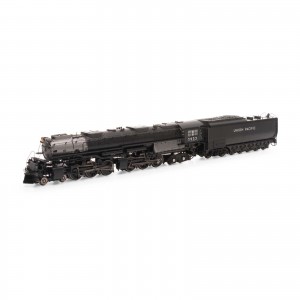Categories
- Advance Reservations
- Couplers, Trucks & Wheels
- Detailing Parts
- Freight Cars & Loads
- Locomotives
- Passenger Cars
- Signals and Lights
- Structures/Scenery & Accessories
- Track & Accessories
- Train Packs/Train Sets
- Vehicles & Figures
- DC/DCC Control
- Adhesives/Lubricants/Tools/Paints
- DVDs, Publications, Decals, Signs etc.
- Order Non Listed Item
- British/European/Japanese
- Kato Unitram & Trams
- HO/OO Scale
- Z Scale
PLEASE NOTE: THESE ARE NOT DC (ANALOGUE) FRIENDLY.
They will only operate at full throttle.
PROTOTYPE SPECIFIC INFORMATION
The name "Challenger" was given to steam locomotives with a 4-6-6-4 wheel arrangement. This means that they have four wheels in the leading pilot truck, which helps guide the locomotive into curves, two sets of six driving wheels, and finally four trailing wheels, which support the rear of the engine and its massive firebox. Each set of six driving wheels is driven by two steam cylinders. In essence, the result is two engines under one boiler. The Union Pacific Railroad sponsored development of this type to meet the need for higher speeds in main-line service. Historically, articulated locomotives had been limited to slow speeds by factors inherent in their design. The technical breakthroughs achieved with the Big Boy enabled the carrier to develop a newer, improved Challenger that met their speed expectations.
Though originally intended for freight service, many Challengers were used in passenger service.
Union Pacific
In the spring of 1941 UP locomotive designers began working on a locomotive to team up with the new 4-8-8-4 Big Boy's then under construction at Alco. The Big Boy's were designed to pull heavy freights up the Wasatch Range in Utah to the division point at Green River, WY. What was needed was a locomotive to take over at that point that could speed the freights eastward across the Wyoming Division. Building on their experience with the original CSA 4-6-6-4 Challengers UP and Alco's designers developed a newer and better Challenger type locomotive. The result was a group of 65 4-6-6-4 Challenger built in three separate groups during World War II.
ROAD NUMBER SPECIFIC FEATURES:
#3985
- Modern Excursion version
- Oil Burner
- Era 1980's - 2000's
#3933
- Coal Burner
- Dual smoke stack
- Tender bunker coal extensions
- Era 1940's - 1959
#3967
- Coal Burner
- Dual smoke stack
- Smoke Lifters
- Era 1940's - 1959
#3997
- Coal Burner
- Dual smoke stack
- Tender bunker coal extensions
- Era 1940's - 1959
Union Pacific
UP painted several of their Challengers in their two-tone grey paint scheme for passenger service. They also added smoke lifters and converted many to oil burners as well.
ROAD NUMBER SPECIFIC FEATURES:
#3976
- Two-tone grey w/ yellow lettering and striping. Oil burner
- Dual smoke stack. Era: Late 1940's - Mid-1950's.
STEAM LOCOMOTIVE FEATURES:
- DCC-ready features Quick Plug™ plug-and-play technology
- Scaled from prototype resources including drawings, field measurements, photographs, and more
- Accurately-painted and –printed paint schemes
- Full cab interior with boiler backhead with printed gauges
- Individually applied piping, valves, generators, etc.
- Operating eccentric cranks on both sides operating in correct direction
- Headlights and indicator number boxes (number boards) with directional light change
- Five pole, skewed armature motor with flywheel for smooth operation
- Pivoting front and rear engines for negotiating 11" radius curves
- See-through running boards
- See-through cab windows
- McHenry® scale knuckle couplers
- LED Lighting for realistic appearance
- Fully-assembled and ready-to-run
- Heavy die-cast frame for greater traction and more pulling power
- Packaging securely holds for the model for safe storage
- Minimum recommended radius: 15"
SOUND EQUIPPED MODELS ALSO FEATURE
- Tender-mounted DCC decoder with SoundTraxx Tsunami2 sound
- Sound, units operate in both DC and DCC
- Full DCC functions available when operated in DCC mode
- Engine, whistle, and bell sounds work in DC
- All functions NMRA compatible in DCC mode
- Excellent Slow speed control
- Many functions can be altered via Configuration Value (CV) changes
- CV chart included in the box






